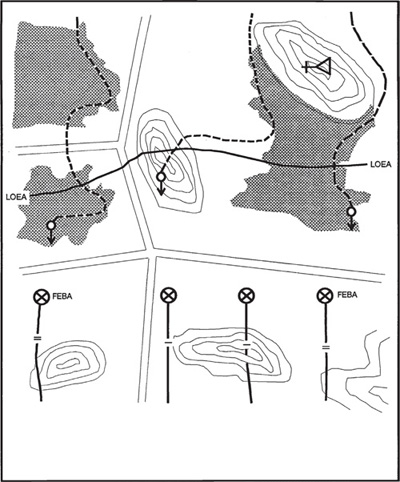
Once again, the IPB process can help in your planning. The two most important products you will develop in CR are situation templates and event templates. It will be helpful to develop a series of situation templates which depict enemy reconnaissance movement. Such templates allow you to develop your event template and let your S3 visualize how you expect the enemy to conduct their reconnaissance battle. Figure 10-6 is a sample of one such situation template.
Situation Template
Do not make the mistake of thinking the enemy’s reconnaissance will use the same AAs as the enemy main force. Remember, enemy reconnaissance elements will most likely operate as two or three vehicles. Such small elements can traverse almost any kind of terrain. Keep in mind, the mission of reconnaissance is to seek and report information, not to fight. Therefore, enemy reconnaissance will use routes that have plenty of concealment and cover.
Also remember, enemy reconnaissance is looking for the best route of attack; the enemy may decide that attacking over rough terrain is preferable to attacking open, but heavily defended, country. For this reason, be sure to consider your entire AI when you develop
Figure 10-6. Situation template of enemy reconnaissance.
your situation templates. Do not get “tunnel vision” and consider only obvious AAs or MCs.
Look at all ways the enemy can enter your sector, including using No-Go terrain! As a general rule, the more concealment or protection a route provides, the more likely it will be used by reconnaissance elements. The outcome of well prepared situation templates is a commander and staff that have a good indication of what the enemy will look like on the battlefield. This eventually will save your R&S assets many hours of unnecessary reconnaissance or surveillance.
Event Template
Based on your situation templates, develop your event template. Your event template will show where on the battlefield you expect to see enemy reconnaissance elements. Then concentrate your R&S attention on those areas (NAI) to detect enemy reconnaissance activity.
Remember, the key to CR intelligence support is finding those enemy reconnaissance units before they can discover friendly positions and report back. Therefore, you must carefully study the effects of weather and terrain on enemy reconnaissance to determine at what point the enemy can observe friendly positions. Usually, this is a function of observation (LOS) and visibility in your unit’s AI.
Compare these limits with the enemy’s known reconnaissance observation capabilities (such as infrared, thermal, light enhancement, and telescopic). As you do this, you will begin to identify a limit of enemy advance (LOEA). Essentially, you must prevent the enemy from going beyond this limit because past that limit, the enemy can observe friendly positions.
Figure 10-7 shows an example of an LOEA, or you can recommend a phase line (PL) that represents the LOEA.

Figure 10-7. Limit of enemy advance.
R&S Plan
You should focus your R&S assets forward of the LOEA to identify enemy reconnaissance before they can spot your unit’s positions. Additionally, your analysis of the terrain may indicate there are isolated terrain features forward of the LOEA you must control to prevent enemy observation of your unit’s position.
For example, you may have determined, based on general terrain and weather conditions, that your LOEA is 5 kilometers in front of your FEBA. However, you discover there are two hills approximately 7 to 8 kilometers in front of your FEBA which allow observation of your unit’s positions. Essentially, those three hills become key terrain for the CR battle. You must prevent the enemy from occupying those hills. Figure 10-8 shows you an example of this.
By integrating your LOEA and key terrain with your event template, you have narrowed the battlefield to specific points or areas where you can focus your R&S assets. You can now go through the process of determining SIR, matching R&S assets with SIR and NAI, and developing detailed R&S instructions.